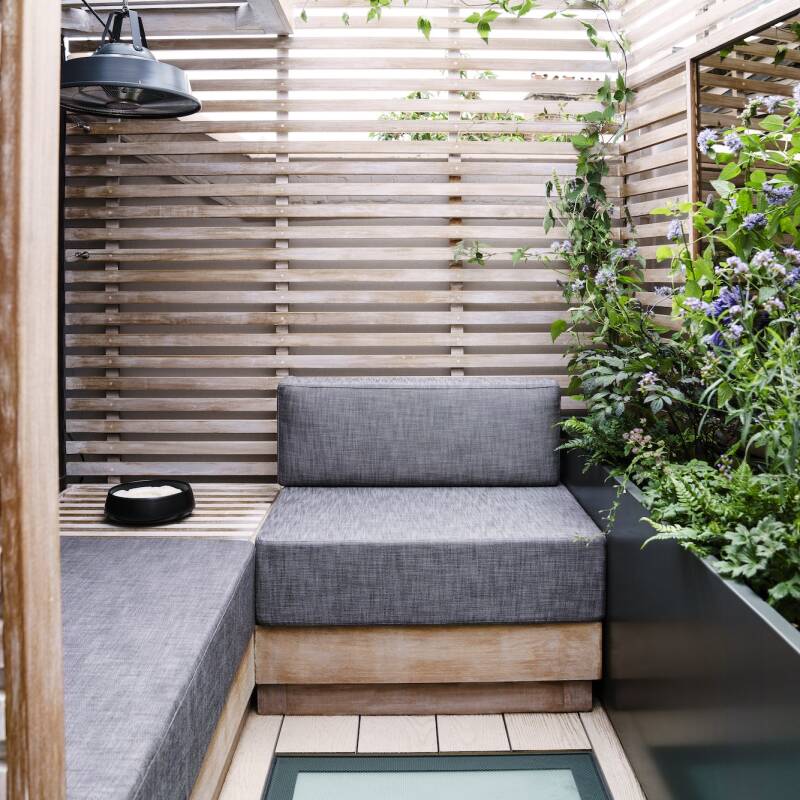As the framing of my new house neared completion and the roofers were about to arrive, I found myself staring at roofs in the area, wondering which type to choose.
I like standing seam metal roofs, but there was the budget to keep in mind. At approximately half the cost, asphalt shingles were the wiser choice. After I made that decision, there were others: color, texture, contrast, and lifespan, all of which required additional thought and research. And in the end? I learned to appreciate asphalt, a material that’s been around for more than 100 years and continues to evolve.

Above: CertainTeed’s triple-laminated Presidential Shake asphalt shingle in charcoal at The Guideboat Company (formerly Mill Valley Lumber). Photograph by Ellen Jenkins.
What are asphalt shingles?
Asphalt shingles (often called composition shingles) were developed in the United States at the turn of the 20th century and have become the country’s most common roofing material. Made of either organic material or fiberglass sandwiched between asphalt and ceramic granules, they are lightweight and easy to install. GAF, Pabco, Malarkey, Owens Corning, CertainTeed, and IKO are some of the main producers. Most asphalt shingles come with warranties of 30 years or longer. Asphalt has certain advantages over other roofing materials such as metal, tile, slate, and wood shake because it’s economical and relatively easy to install and maintain.
What are the different types of asphalt shingles?
There are two main types:
- 3-tab shingles have two cutouts along the longer edge to give the appearance of three equal-sized shingles. They are, lighter, flatter, and cheaper than laminated shingles. While many roofing contractors recommend laminated shingles for their longevity, I liked the simplicity and uniformity of 3-tab shingles. When it comes time for a new roof, 3-tab shingles have an advantage; a layer of new shingles can be added without removing the old.
- Laminated shingles (also known as dimensional shingles or architectural shingles) have a heavier base mat to which two or three shingles of varying sizes are adhered (making them up to 50 percent heavier than 3-tabs). The thickness and texture can make them appear more like slate or wood shake. Laminated shingles usually have longer warranties and can withstand stronger winds than 3-tabs (and are more expensive). Of the many varieties of laminated shingles available, one of my favorites is a shadowed stair-step style offered by several manufacturers: GAF’s Grand Sequoia and CertainTeed’s Presidential Shake (Above) are examples.

Above: Laminated charcoal-colored asphalt shingles on a house designed by Ken Linsteadt Architects.
What colors are available?
After I zeroed in on my style and texture preferences, I had to choose a color. Colors range from varying shades of gray, brown, green, red, and blue. Most manufacturers offer lines with either high degrees of color contrast (sometimes called “high-definition”) in which different color granules are applied to give the shingles a variegated look. I preferred the more even-toned lines, such as GAF’s Natural Shadow shingles and the 3-tab lines from Pabco and Malarkey.
One color, Weathered Wood, reminiscent of an old wooden fence and offered by many manufacturers, is a neutral that works with almost any house color. Charcoal, a dark gray, is also a good neutral, although it may absorb more heat if high temperatures are an issue in your region. For a less-neutral look, Malarkey and Pabco offer red and green color options in their 3-tab lines, both of which work well with a cream or white house. Maple Red by Pabco is used on the buildings of one my favorite areas of San Francisco, the former military base called the Presidio. The roofs blend beautifully with the nearby Golden Gate Bridge.

Above: A roof of 3-tab shingles in Maple Red on a San Francisco Presidio building. Photograph by Ellen Jenkins.

Above: Laminated shingles in a Weathered Wood color in Mill Valley. Photograph by Ellen Jenkins.
How much do asphalt roof shingles cost?
The cost of asphalt shingles for a 2,000-square-foot house ranges from $1,000 to $4,000, with installation costs ranging anywhere from $2,000 to $9,000, depending on your area and the configuration and steepness of your roof. You also need to figure in the cost of removal of an old roof and any repairs to the roofing membrane.

Above: 3-tab shingles cover walls as well as a roof designed by DesignOffice, in Australia. Photograph courtesy of DesignOffice.
Asphalt Shingles Recap:
Pros
- Economical.
- Durable.
- Relatively easy to install and repair.
- Fire and wind resistant.
Cons
- Shorter life expectancy than metal or tile.
- Spent asphalt shingles often end up in landfills (though some recycling services are becoming available).
- Should not be used on low-pitched roof (17% slope or less).
- Extreme temperature changes can cause material to oxidize and become brittle.
- Can be damaged by hail.
Would you dare to use asphalt indoors? See it put to use as flooring in Rare Fruit: Design Distilled in Southern Germany on Remodelista.
Are you choosing materials for a remodeling project? Browse our other Hardscaping 101 posts.








Have a Question or Comment About This Post?
Join the conversation